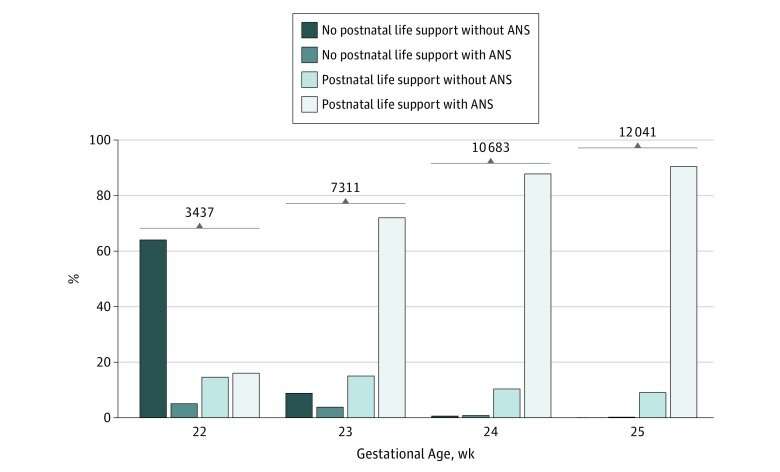Proportion of infants receiving postnatal life support, by gestational age at birth. The mean percentage of infants receiving no postnatal life support without antenatal steroids (ANS) exposure, no postnatal life support with ANS exposure, postnatal life support without ANS exposure, and postnatal life support with ANS exposure are shown for each gestational age, 22 to 25 weeks. Numbers above bars indicate sample size at each gestational age. Credit: JAMA Network Open (2022). DOI: 10.1001/jamanetworkopen.2022.33331
Steroid treatment before birth appears to improve survival and reduce complications among extremely preterm infants, according to a new study. Antenatal steroid therapy, given to women at risk of preterm delivery, causes the fetal lungs to mature and has been shown to improve survival and reduce complications among infants born from 24 to 34 weeks of pregnancy. However, previous studies of the treatment for infants born between the 22nd and 23rd week—those at greatest risk for death and disability—were inconclusive.
The study was conducted by Sanjay Chawla, M.D., at Central Michigan University, Mount Pleasant, and Wayne State University, Detroit, and colleagues at 17 U.S. research institutions. It appears in JAMA Network Open.
Of the mothers of the 431 infants in the study, 110 did not receive the steroid betamethasone, 80 received partial treatment (one dose) and 241 received complete treatment (two doses 24 hours apart).
Of the infants exposed to complete treatment, 53.9% survived until hospital discharge, compared to 37.5% with partial treatment and 35.5% with no treatment. Compared to infants receiving no treatment, infants exposed to full treatment were 1.95 times more likely to survive and 2.74 times more likely to survive without major complications such as severe bleeding in the brain, severe lung disease (bronchopulmonary dysplasia), cysts in brain, severe inflammation of the intestines (necrotizing enterocolitis) or abnormal blood vessel growth in the retina (retinopathy of prematurity needing treatment).
The study authors concluded that their results provide strong evidence to support giving antenatal steroid therapy to pregnant people at risk for delivery at 22 weeks.
More information: Sanjay Chawla et al, Association of Antenatal Steroid Exposure at 21 to 22 Weeks of Gestation With Neonatal Survival and Survival Without Morbidities, JAMA Network Open (2022). DOI: 10.1001/jamanetworkopen.2022.33331
Journal information: JAMA Network Open
Provided by National Institutes of Health






















